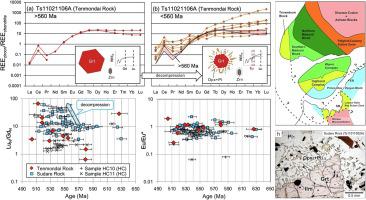当前位置:
X-MOL 学术
›
Precambrian. Res.
›
论文详情
Our official English website, www.x-mol.net, welcomes your
feedback! (Note: you will need to create a separate account there.)
U–Pb geochronology and REE geochemistry of zircons in mafic granulites from the Lützow-Holm Complex, East Antarctica: Implications for the timing and P–T path of post-peak exhumation and Antarctica–Sri Lanka correlation
Precambrian Research ( IF 3.2 ) Pub Date : 2020-09-01 , DOI: 10.1016/j.precamres.2020.105850 Yusuke Takamura , Toshiaki Tsunogae , Yukiyasu Tsutsumi
Precambrian Research ( IF 3.2 ) Pub Date : 2020-09-01 , DOI: 10.1016/j.precamres.2020.105850 Yusuke Takamura , Toshiaki Tsunogae , Yukiyasu Tsutsumi

|
Abstract We report new petrological and geochronological data, together with zircon REE patterns, of mafic granulites from the Lutzow-Holm Complex (LHC), East Antarctica, and investigate the pressure-temperature-time (P-T-t) evolution of granulite-facies metamorphism in order to unravel the timing and tectonics of Neoproterozoic collisional processes related to the amalgamation of Gondwana. The LHC is composed of three tectonic units: a ca. 2.5 Ga continental fragment (Shirase Microcontinent), a ca. 1.0 Ga magmatic arc (Prince Olav–Vijayan Block; PVB), and a latest Neoproterozoic suture zone (Lutzow-Holm Bay Suture Zone; LHSZ) separating the two. Mafic granulites from Tenmondai Rock and Sudare Rock, which belong to the PVB and the LHSZ, respectively, contain orthopyroxene + plagioclase symplectites around garnets, probably formed during post-peak decompression. The application of phase equilibrium modeling and geothermobarometry indicates similar peak P-T ranges of 850–860 °C/7.8–8.4 kbar (Tenmondai Rock) and 800–810 °C/8.5–9.0 kbar (Sudare Rock), together with clockwise P-T paths for both localities. LA-ICP-MS zircon U-Pb dating of the studied granulites yielded Mid-Neoproterozoic magmatic ages of >808 Ma (Tenmondai Rock) and >783 Ma (Sudare Rock) from igneous cores, and Late Neoproterozoic to Cambrian metamorphic ages of ca. 630–481 Ma from overgrown rims and/or structureless grains. Zircon REE analyses indicate that younger 560–510 Ma metamorphic zircons from the localities exhibit heavy-REE-enriched patterns and negative Eu anomalies, suggesting that the consumption of garnet and growth of plagioclase took place during zircon growth. This process was probably related to the formation of post-peak decompressional textures (orthopyroxene + plagioclase symplectite around garnet) observed in the mafic granulites. The results of this study therefore indicate that post-peak exhumation of the LHC started at ca. 560 Ma. Available U-Pb and REE data from 560 to 510 Ma metamorphic zircons of the Highland Complex, Sri Lanka, show similar heavy-REE-enriched patterns and Eu negative anomalies, suggesting that post-peak exhumation of both the LHC and the Highland Complex took place almost simultaneously at ca. 560 Ma. The results of this study further support the proposed tectonic model in which the Highland Complex and the LHSZ are parallel collisional sutures formed during the Late Neoproterozoic-Cambrian Gondwana amalgamation.
中文翻译:

南极东部 Lützow-Holm 杂岩体中镁铁质麻粒岩中锆石的 U-Pb 年代学和 REE 地球化学:对峰后折返时间和 P-T 路径的影响以及南极-斯里兰卡相关性
摘要 我们报告了来自南极洲东部 Lutzow-Holm 杂岩体 (LHC) 的镁铁质麻粒岩的新岩石学和地质年代学数据以及锆石 REE 模式,并研究了麻粒岩相变质作用的压力-温度-时间 (PTt) 演化。解开与冈瓦纳大陆合并相关的新元古代碰撞过程的时间和构造。LHC 由三个构造单元组成:一个约。2.5 Ga 大陆碎片(Shirase Microcontinent),约 1.0 Ga 岩浆弧(Prince Olav-Vijayan Block;PVB),以及将两者分开的最新的新元古代缝合带(Lutzow-Holm Bay 缝合带;LHSZ)。分别属于 PVB 和 LHSZ 的 Tenmondai Rock 和 Sudare Rock 的镁铁质麻粒岩在石榴石周围含有斜辉石 + 斜长石 symplectites,可能是在峰后减压过程中形成的。相平衡模型和地热气压计的应用表明 850–860 °C/7.8–8.4 kbar(Tenmondai Rock)和 800–810 °C/8.5–9.0 kbar(Sudare Rock)的类似峰值 PT 范围,以及顺时针 PT 路径两个地方。LA-ICP-MS 锆石 U-Pb 定年研究的麻粒岩产生了来自火成岩核的 >808 Ma(Tenmondai 岩)和 >783 Ma(Sudare 岩)的中新元古代岩浆年龄,以及新元古代晚期至寒武纪约 630–481 Ma 来自过度生长的边缘和/或无结构的颗粒。锆石稀土元素分析表明,当地较年轻的 560-510 Ma 变质锆石表现出重稀土富集模式和负 Eu 异常,表明石榴石的消耗和斜长石的生长发生在锆石生长过程中。这一过程可能与在镁铁质麻粒岩中观察到的峰后减压结构(石榴石周围的斜辉石 + 斜长石辛辉石)的形成有关。因此,这项研究的结果表明,大型强子对撞机的峰后挖掘开始于大约。560 马。斯里兰卡高地杂岩体 560 至 510 Ma 变质锆石的 U-Pb 和 REE 数据显示类似的重稀土富集模式和 Eu 负异常,表明 LHC 和高地杂体的峰后折返几乎同时放置在ca。560 马。这项研究的结果进一步支持了所提出的构造模型,其中高地杂岩体和 LHSZ 是在新元古代晚期 - 寒武纪冈瓦纳融合过程中形成的平行碰撞缝合线。
更新日期:2020-09-01
中文翻译:

南极东部 Lützow-Holm 杂岩体中镁铁质麻粒岩中锆石的 U-Pb 年代学和 REE 地球化学:对峰后折返时间和 P-T 路径的影响以及南极-斯里兰卡相关性
摘要 我们报告了来自南极洲东部 Lutzow-Holm 杂岩体 (LHC) 的镁铁质麻粒岩的新岩石学和地质年代学数据以及锆石 REE 模式,并研究了麻粒岩相变质作用的压力-温度-时间 (PTt) 演化。解开与冈瓦纳大陆合并相关的新元古代碰撞过程的时间和构造。LHC 由三个构造单元组成:一个约。2.5 Ga 大陆碎片(Shirase Microcontinent),约 1.0 Ga 岩浆弧(Prince Olav-Vijayan Block;PVB),以及将两者分开的最新的新元古代缝合带(Lutzow-Holm Bay 缝合带;LHSZ)。分别属于 PVB 和 LHSZ 的 Tenmondai Rock 和 Sudare Rock 的镁铁质麻粒岩在石榴石周围含有斜辉石 + 斜长石 symplectites,可能是在峰后减压过程中形成的。相平衡模型和地热气压计的应用表明 850–860 °C/7.8–8.4 kbar(Tenmondai Rock)和 800–810 °C/8.5–9.0 kbar(Sudare Rock)的类似峰值 PT 范围,以及顺时针 PT 路径两个地方。LA-ICP-MS 锆石 U-Pb 定年研究的麻粒岩产生了来自火成岩核的 >808 Ma(Tenmondai 岩)和 >783 Ma(Sudare 岩)的中新元古代岩浆年龄,以及新元古代晚期至寒武纪约 630–481 Ma 来自过度生长的边缘和/或无结构的颗粒。锆石稀土元素分析表明,当地较年轻的 560-510 Ma 变质锆石表现出重稀土富集模式和负 Eu 异常,表明石榴石的消耗和斜长石的生长发生在锆石生长过程中。这一过程可能与在镁铁质麻粒岩中观察到的峰后减压结构(石榴石周围的斜辉石 + 斜长石辛辉石)的形成有关。因此,这项研究的结果表明,大型强子对撞机的峰后挖掘开始于大约。560 马。斯里兰卡高地杂岩体 560 至 510 Ma 变质锆石的 U-Pb 和 REE 数据显示类似的重稀土富集模式和 Eu 负异常,表明 LHC 和高地杂体的峰后折返几乎同时放置在ca。560 马。这项研究的结果进一步支持了所提出的构造模型,其中高地杂岩体和 LHSZ 是在新元古代晚期 - 寒武纪冈瓦纳融合过程中形成的平行碰撞缝合线。











































 京公网安备 11010802027423号
京公网安备 11010802027423号